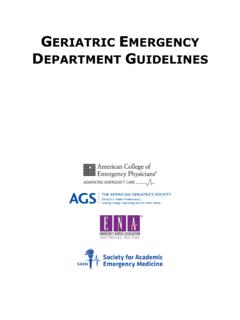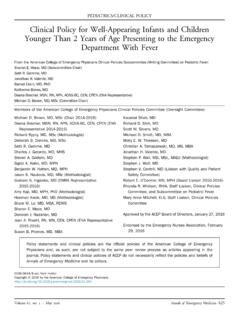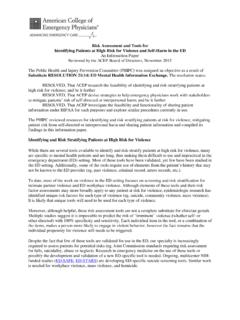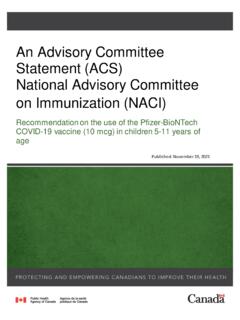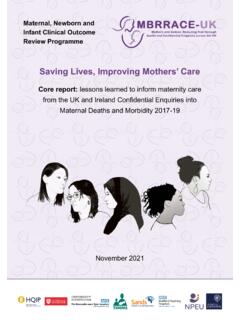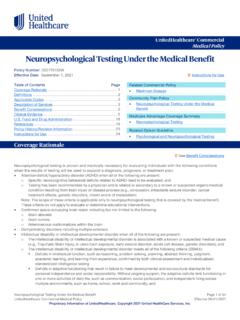Transcription of Evidence-Based Guideline: Treatment of Convulsive Status ...
1 48 The following organizations have endorsed this guideline: epilepsy Foundation Child Neurology Society American College of Emergency Physicians Association of Child Neurology Nurses American Association of Neuroscience Nurses epilepsy Currents, Vol. 16, No. 1 (January/February) 2016 pp. 48 61 American epilepsy SocietyAmerican epilepsy Society Guideline Evidence-Based Guideline: Treatment of Convulsive Status Epilepticus in Children and Adults: Report of the Guideline Committee of the American epilepsy SocietyTracy Glauser, MD,1 Shlomo Shinnar, MD, PhD,2 David Gloss, MD,3 Brian Alldredge, PharmD,4 Ravindra Arya, MD, DM,1 Jacquelyn Bainbridge, PharmD,5 Mary Bare, MSPH, RN1, Thomas Bleck, MD,6 W.
2 Edwin Dodson, MD,7 Lisa Garrity, PharmD,8 Andy Jagoda, MD,9 Daniel Lowenstein, MD,10 John Pellock, MD,11 James Riviello, MD,12 Edward Sloan, MD, MPH,13 David M. Treiman, MD141 Division of Neurology, Comprehensive epilepsy Center, Cincinnati Children s Hospital Medical Center and University of Cincinnati College of Medicine, Cincinnati, OH2 Departments of Neurology, Pediatrics, and Epidemiology and Population Health, and the Comprehensive epilepsy Management Center, Monte-fiore Medical Center, Albert Einstein College of Medicine, Bronx, NY3 CAMC Neurology Group, Charleston, WV4 School of Pharmacy, University of California, San Francisco, CA5 Department of Clinical Pharmacy, University of Colorado.
3 Skaggs School of Pharmacy and Pharmaceutical Sciences, Aurora, CO6 Departments of Neurological Sciences, Neurosurgery, Medicine, and Anesthesiology, Rush University Medical Center, Chicago, IL7 Departments of Neurology and Pediatrics, Washington University School of Medicine, St. Louis, MO8 Division of Pharmacy, Cincinnati Children s Hospital Medical Center, Cincinnati, OH9 Department of Emergency Medicine, Mount Sinai Hospital, Mount Sinai School of Medicine, New York, NY10 Department of Neurology, University of California, San Francisco, CA11 Division of Pediatric Neurology, Virginia Commonwealth University, Richmond, VA12 NYU Comprehensive epilepsy Center, New York, NY13 Department of Emergency Medicine, University of Illinois at Chicago, Chicago, IL14 Division of Neurology, Barrow Neurological Institute, Phoenix.
4 AZAddress correspondence to Tracy Glauser, MD, Cincinnati Children s Hospital Medical Center, Division of Neurology, MLC 2015, 3333 Burnet Ave., Cincinnati, OH : The optimal pharmacologic Treatment for early Convulsive Status epilepticus is unclear. OBJECTIVE: To analyze ef-ficacy, tolerability and safety data for anticonvulsant Treatment of children and adults with Convulsive Status epilepticus and use this analysis to develop an Evidence-Based Treatment algorithm. DATA SOURCES: Structured literature review using MEDLINE, Embase, Current Contents, and Cochrane library supplemented with article reference lists.
5 STUDY SELECTION: Randomized controlled trials of anticonvulsant Treatment for seizures lasting longer than 5 minutes. DATA EXTRACTION: Individual studies were rated using predefined criteria and these results were used to form recommendations, conclusions, and an Evidence-Based Treatment algorithm. RESULTS: A total of 38 randomized controlled trials were identified, rated and contributed to the assess-ment. Only four trials were considered to have class I evidence of efficacy. Two studies were rated as class II and the remaining 32 were judged to have class III evidence.
6 In adults with Convulsive Status epilepticus, intramuscular midazolam, intravenous lorazepam, intravenous diazepam and intravenous phenobarbital are established as efficacious as initial therapy (Level A). Intra-muscular midazolam has superior effectiveness compared to intravenous lorazepam in adults with Convulsive Status epilepticus without established intravenous access (Level A). In children, intravenous lorazepam and intravenous diazepam are established as efficacious at stopping seizures lasting at least 5 minutes (Level A) while rectal diazepam, intramuscular midazolam, intranasal midazolam, and buccal midazolam are probably effective (Level B).
7 No significant difference in effectiveness has been demon-strated between intravenous lorazepam and intravenous diazepam in adults or children with Convulsive Status epilepticus (Level A). Respiratory and cardiac symptoms are the most commonly encountered Treatment -emergent adverse events associated with intravenous anticonvulsant drug administration in adults with Convulsive Status epilepticus (Level A). The rate of respiratory depression in patients with Convulsive Status epilepticus treated with benzodiazepines is lower than in patients with convul-49 Convulsive Status Epilepticus GuidelineBackgroundTraditionally, brief seizures are defined as lasting less than 5 minutes, while prolonged seizures last between 5 and 30 min-utes; Status epilepticus is defined as more than 30 minutes of either 1) continuous seizure activity or 2) two or more sequen-tial seizures without full recovery of consciousness between seizures (1).
8 The 30-minute definition is based on the duration of Convulsive Status epilepticus that may lead to permanent neuronal injury by itself (2). Since the majority of seizures are brief, and once a seizure lasts more than 5 minutes it is likely to be prolonged (3), Status Treatment protocols have used a 5-minute definition to minimize both the risk of seizures reaching 30 minutes and the adverse outcomes associated with needlessly intervening on brief, self-limited seizures (2, 4). This guideline follows this convention and, for purposes of Treatment , uses the term Status epilepticus to represent stud-ies involving both prolonged seizures and traditionally defined Status epilepticus presents in several forms: 1) Convulsive Status epilepticus consisting of repeated generalized tonic clonic (GTC) seizures with persistent postictal depression of neurologic function between seizures; 2) nonconvulsive Status epilepticus where seizures produce a continuous or fluctuat-ing epileptic twilight state.
9 And 3) repeated partial seizures manifested as focal motor signs, focal sensory symptoms, or focal impairment of function ( , aphasia) not associated with altered awareness (epilepsia partialis continua).Between 50,000 and 150,000 Americans each year have Status epilepticus (5 7), with mortality estimated at less than 3% in children but up to 30% in adults (5, 6, 8). The goal of therapy is the rapid termination of both clinical and electrical seizure activity, since appropriate and timely therapy of Status epilepticus reduces the associated mortality and morbidity (9).
10 Ultimately, the prognosis is most strongly related to the etiol-ogy, duration of Status epilepticus, and the age of the patient (10 12). Basic critical care and emergency principles of therapy such as supporting respiration, maintaining blood pressure, gaining intravenous (IV) access, and identifying and treating the underlying cause have achieved widespread acceptance and are routinely implemented by both neurologists and non-neurologists. Despite this recognition of the need to address Status epilepticus as a critical care emergency, the goals of therapy and approaches to the pharmacologic Treatment of Status epilepticus continue to vary dramatically.
